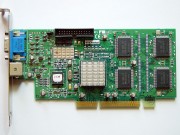elianda wrote:Powerstrip says:
My Rage IIC AGP 62 MHz (no info if core or memory), does 147 3DMark99
Rage Pro Turbo PCI Core 75 MHz, Memory 10 […]
Show full quote
Powerstrip says:
My Rage IIC AGP 62 MHz (no info if core or memory), does 147 3DMark99
Rage Pro Turbo PCI Core 75 MHz, Memory 100 MHz.
The Rage Pro feels at least 10 times faster.
Somehow I missed the post of your Rage II and Pro recordings back in March, but you're not kidding when you say the Rage Pro is faster. 😉
The Rage II you tested seems to be fairly comparable in speed to your S3 Trio 3D with a few differences in bugs/driver issues in those benchmarks. The Virge seems to have an advantage in visual quality in some areas (including filtered translucent textures), but seems to be similar in general. Albeit, I'd imagine a considerably greater difference for drivers/applications properly supporting 32-bit rendering on the Virge -as with Incoming. Both also have the issue of lacking OpenGL support. (or does the Rage II have OpenGL drivers?)
On another note, (when working properly) both the Rage II and Trio 3D seem noticeably faster than the Rendition Verte V1000. (though still significantly slower than the Vooodoo)
The Rage Pro recordings seem to show similar performance to the Riva 128, but with different artifacts (seaming and Z-fighting seem to be much less prominent though). The dithering is much less noticeable than the Rage II and maybe the Riva too. (it's hard to notice any dithering in some of the videos)
The helicopter sequence in 3DMark 2000 also seems to have different ground textures (all green rather than brown/tan areas) unlike the other captures. (including the Rage II) This seems rather odd.



